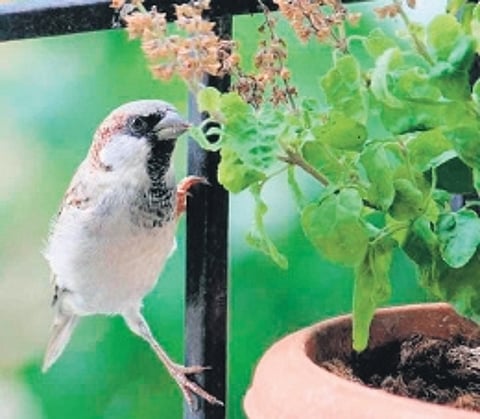

HYDERABAD: It’s a spring morning in a concrete jungle, and instead of the irritating alarms, the chirping sounds of birds wake you up. As you peek from your window or balcony, you catch sight of charming little sparrows. Familiar, right? Consider yourself fortunate to envision this scenario, as future generations might not have the opportunity due to the gradual decline in sparrow populations. To protect and address the challenges they face in urban habitats, March 20 is celebrated as World Sparrow Day. CE speaks with experts to learn more about this species.
Describing the significance of the sparrow across cultures, Sri Ram Reddy, wildlife photographer, explained, “In Indian mythology, the sparrow bird is linked with themes of love, companionship, and devotion. When it comes to Chinese mythology, sparrows were believed to bring joy and were often associated with the arrival of spring. They also symbolise love and fidelity, as seen in the famous Chinese folktale ‘The Weaver Girl and the Cowherd,’ where two lovers transformed into sparrows. While in Japan, sparrows, known as ‘suzume,’ are considered symbols of hard work, community, and perseverance. In ancient Egyptian culture, sparrows were associated with the goddess Isis, who was often depicted with wings.”
Though multiple types of sparrows exist, there is a decline in sparrow populations. Pointing out a few reasons behind this, Sri Ram Reddy said, “The primary cause of the decline in sparrow populations remains elusive, but it is widely believed that factors such as the lack of available nesting sites due to modernisation, construction, and deforestation play a significant role. Other potential contributors include the widespread use of insecticides, competition with other species, and the rapid pace of urban development. Modern housing designs often offer limited space for sparrows to construct their nests, exacerbating their challenges in finding suitable habitats.”
Community-driven initiatives can help in a resurgence of sparrows in our surroundings. Suggesting a few practical initiatives, Dr Sindhura Pothineni, cosmetic dentist, and an animal rescuer said, “Bird feeders, water bowls, and nesting boxes provide essential resources and attract groups of birds, while community awareness campaigns on social media and in schools foster understanding and responsibility. Birdwatching camps, lake cleanups, and advocacy for policy changes further support bird conservation efforts. Expanding protected areas offers vital sanctuaries for diverse bird species.”
Sharing one of her experiences in rescuing sparrows, she said, “Once there Swas a rescue where the mother sparrow died, leaving her nestlings still in the nest. A person rescued the three of them, but due to a lack of proper knowledge and failure to research their diet or reach out to a wildlife NGO, they attempted to raise them themselves. Unfortunately, because of an improper diet, two of them passed away. They then reached out to me for help. I immediately took them in, but she (the bird) was very weak. With the assistance of an avian vet, constant care, and the correct diet, she thrived and was released back into her habitat where they were found. (A rescue is only successful when they return to their habitat).”